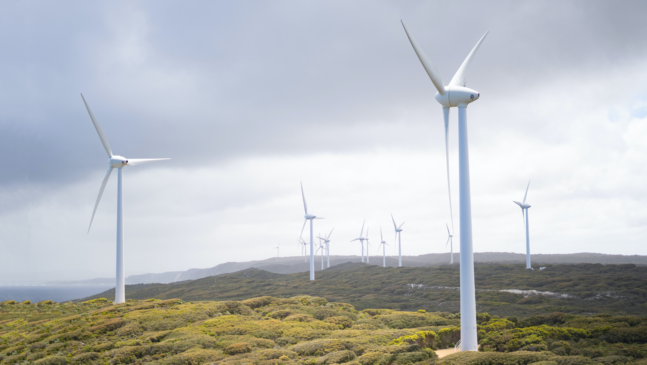In this article Tim Benson, Chair and Project Lead for Powerful Thinking, looks at renewable energy generation in the UK; examining the inefficiency of National Grid storage systems for renewable energy and the grid-balancing policy, involving ‘constraint payments,’ which sees wind farm operators paid to curtail generation when supply exceeds demand.
Tim examines why the government’s net zero strategy, involving the commission of more nuclear power plants, will do nothing to stop ‘constraint payments’ and looks to a more hopeful future with UK companies, Noriker and Zenobe, advancing battery farm technology capable of storing surplus renewable energy for the grid: Plus, how this technology is entering the mobile energy storage market, with products being tailored for the live events sector and other temporary applications.
2022 was a record-breaking year in the UK for renewable energy generation, with an average of 40% of our electricity generated through renewables – hydro 1.8%, solar 4.4%, biomass 5.2% and wind 26.8%. And even though we have not yet reached the end of Q1 for 2023, we are already setting new records. On 10th January, there was a half hour window where UK wind turbines generated 21.6GW of power, which at the time accounted for 50.4% of the UK’s energy mix.
So, you might be surprised to learn that in the first 11 months of 2022, the National Grid paid out £122m to wind farm operators to temporarily deactivate their turbines, with an additional spend of £82m required for December alone. Referred to as ‘constraint payments’, these subsidies are designed to compensate wind farm operators for curtailing their generation at times when supply exceeds demand. This is part of the National Grid’s electricity system operator (NGESO’s) grid balancing strategy, designed to ensure that supply always meets demand. Where demand rises, power may be imported from overseas or power station generation ramped up. However, where supply exceeds demand, the current solution is to reduce the percentage contribution of renewables into the energy mix. In 2022 alone, the costs for implementing NGESO’s grid balancing strategy reached £4.2bn, a good portion of which is passed onto consumers. According to The Nuclear Industry Association (NIA), last year this accounted for an additional spend of £150 per UK household.
The crucial question here is why does NGESO’s grid balancing strategy favour fossil fuels and/or nuclear generation over that of renewables? In order to understand this, we need to explore the differences between embedded and distributed generation and how our electrical supplies are distributed nationally.
Embedded generation is defined as the production of electricity, typically from thermal generating power plants where fuel is heated to create steam that drives electricity generating turbines. These power stations are always online and generating power, with the ability to ramp up quickly where demand increases; this is referred to as a demand side response model. Supplies from distributed generation through renewables are more intermittent, in that their generation is always dependent on either the prevailing climate or the time of day. As such, they are not considered predictable or reliable enough to supply our national network with the necessary base load power.
However, it should be noted here that the government’s strategy to reach net zero emissions by 2050, involves the commissioning of more nuclear power plants. Unlike conventional power stations, nuclear plants are commonly run at full capacity and their operators are both reluctant, and often technically unable, to ramp up and down in response to fluctuations in grid requirements. This inflexibility makes them poor partners for a power network that relies on both embedded and distributed generation and will do nothing to curtail constraint payments.
Embedded generation is also connected directly to our high voltage (HV) transmission network managed by NGESO. This transmission network connects to localised distribution networks, managed by district network operators (DNOs), who then supply power to our homes and businesses. Currently distributed generation only connects at a distribution network level, i.e. generation is at the point of consumption and can only service demand within a DNOs localised distribution network. In the same way that generation exists at the point of consumption, so consumption must occur at the point of generation. Where demand is low and a surplus accrues, there is no scope to redirect this power to other regions, because NGESO’s outdated transmission network cannot physically support this.
Advocates of renewables have long been arguing the case for the integration of battery energy storage systems (BESS) to assist with grid balancing. Battery farms could store any surplus energy until such a time as demand increases again, therefore reducing our dependence on fossil or nuclear power station supplies at times of peak demand. A number of UK based companies, including Noriker and Zenobe are making excellent progress in this sector. Indeed, Zenobe has just achieved a remarkable first with their commissioning of a 100MW/107MWh battery energy storage system in Capenhurst, Chester. This facility is hailed as the largest battery project directly connected to the transmission grid anywhere in Europe and is able to deliver reactive power services. Zenobe’s ambition is to reduce the amount of curtailment of renewable energy, particularly wind, in the Mersey region of north-west England where it is located, as well as reducing the amount of gas-fired generation needed to balance the supply and demand of electricity. Interestingly, both Noriker and Zenobe have also entered the mobile energy storage market, with products and control systems being tailored for event and other temporary applications. This kind of diversification is essential if we are genuinely looking to decarbonise generation in the live events sector, so keep an eye out for them both!
This guest blog originally appeared in the February 2023 Vision: 2025 newsletter. Sign up to receive monthly event sustainability news, case studies and guest blogs direct to your inbox www.vision2025.org.uk
Tim Benson is Chair & Project Lead for Powerful Thinking, the outdoor events sustainable energy working group, & also sits on the Live Green sustainability working group. He has contributed content for a wide range of industry papers and is the author of the energy chapter in the Show Must Go Report. He is also the Founder/Production Director of Smart Power Ltd & Technical Director at ZAP Concepts UK & Ireland.

